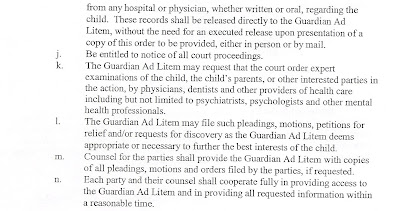Jenny's two mothers, "Barbara" and "Tracy," had entirely different plans for the 23rd -- a Wednesday, when Barbara normally finished work early.
Tracy says she had made an appointment a few weeks earlier for both of them and their daughter to meet Attorney Christopher Corbett, who advertised mediation services in Options Magazine to the LGBT community. Tracy was to pick up Jenny from school and meet Barbara at Corbett's office for a free initial interview at 4 p.m. on Wednesday, April 23rd, to consider working with him on their family's issues.
Barbara had another plan: On April 22nd, she met with Attorneys Cynthia Gifford and Cherrie Perkins to work on a "Motion for Ex Parte Relief," a 12-point "Affidavit in Support of Emergency Order," a 24-point "Miscellaneous Complaint for Custody and Other Relief," and a partially completed list of her bank accounts, income and expenses.
On the 23rd, without notifying Tracy, Gifford and Perkins persuaded Judge D'Ambra to sign an emergency ex parte order awarding Barbara sole custody of Jenny. The documents they prepared are in the court file and entered on the docket sheet the following day. Apparently no record was kept of what they told the judge.
(Click once on documents to enlarge.)That afternoon, as Tracy and Jenny arrived at Corbett's office, Gifford and Perkins were preparing a subpoena summoning Tracy to a hearing one month later on May 21st and informing her that "the Court has already issued Orders pending the hearing as set forth in the attached Ex Parte Order."
A transcript tells what happened the next day, on the 24th, when attorney Perkins appeared alone at a second ex parte hearing and asked Judge D'Ambra to give Barbara complete control over Tracy's contact with their daughter.
Here's how Perkins portrayed Tracy's actions the previous day:
Your Honor, after I was here yesterday, we informed our client [Barbara] of the court order and gave her a certified copy. We did advise her to contact the Defendant [Tracy]. . . and tell her that she'd retained counsel and give our name and tell her that there had been an order entered; and upon hearing that, the Defendant became a little upset and removed the child from school early, and this was not her day to have the child. . . . The Defendant took her to an attorney's office, which would be a violation of the order . . . . My office received a call . . . from attorney Chris Corbett, saying that he was sitting with the Defendant at the time, which would lead me to believe the minor child was there with him . . . . We left a message [for Corbett] this morning saying if you're going to enter your appearance, you should get down to Washington County Court . . . .Still hoping to mediate, Corbett waited two weeks before entering his appearance as Tracy's lawyer on May 9th. He and Tracy worked that summer on a settlement, which Barbara and her attorneys rejected. The court hearings were all held without Corbett, and Tracy never met Judge D'Ambra.
Gifford and Perkins had composed the April 23rd order, but Judge D'Ambra inserted additional words: "pending a hearing on the motions" on May 21st. That hearing never occurred, though a key order was signed that day.
Shortly after noon on May 16th Gifford and Perkins faxed a "Consent Order" (perhaps to Corbett) purporting to reflect a hearing five days later on May 21st, "without the taking of testimony." Whether or not the scrawl identified as Corbett's signature was authentic, Judge D'Ambra signed the document that appointed attorney Kerry Rafanelli to be guardian ad litem for Jenny.
Though the judge apparently wrote "8/13" for the next hearing, Rafanelli was back in court on June 24th with his boilerplate order drawn up for the judge's signature, granting him all-encompassing authority without clarifying the cost or setting a limit on the tens of thousands of dollars he could charge Jenny's mothers while exerting complete control over their lives as guardian ad litem.
The Court defines this role in the broadest possible terms. The abuse of power by guardians ad litem , the damage they do to children and families, and their enormous bills are some of the most common complaints against Family Court.
Six days after Judge D'Ambra signed that order, Rafanelli wrote to Tracy and Barbara, once again without ever discussing the cost: "At this time I think it is in the best interests of the minor child to be involved in counseling" with psychologist Judith Lubiner.
Those first nine weeks reveal the patterns that played out repeatedly and still continue in this case and other color-of-law custody cases:
1. the use of ex parte emergency motions;Three years later, Dr. Lubiner sat beside Attorney Rafanelli at a hearing of the Judicial Nominating Commission, forced to listen as Tracy and other parents testified against Rafanelli's bid to become a judge. Commissioners received 69 letters of support for him--17 more than the other eight candidates combined. His pile included a 4-page letter from Lubiner, two pages from Gifford and Perkins and two each from Judge Shawcross and Judge DiSegna. Those enthusiastic accolades may have hurt as much as the attacks did, for Commissioners dropped him on their first ballot.
2. failure to notify the other side of court hearings;
3. creating fraudulent narratives, story-lines, and court histories;
4. accusing the other side of violating court orders that were not yet entered;
5. bullying and harassing the other side;
6. creating a professional cabal to financially exploit litigants and their children.
(The Rhode Island Monthly lionized Attorney Kerry Rafanelli and two other guardians ad litem in their October 2003 issue.)
For more on cabals of court, see the February 22 and March 16, 2012, posts at
http://CustodyScam.blogspot.com
and
http://LittleHostages.blogspot.com/2009/12/why-did-lise-iwon-do-it.html





